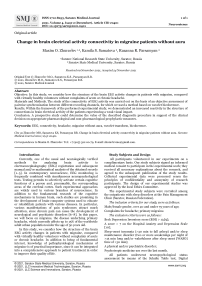Change in brain electrical activity connectivity in migraine patients without aura
Автор: Maxim O. Zhuravlev, Kamila S. Samatova, Ruzanna R. Parsamyan
Журнал: Saratov Medical Journal @sarmj
Статья в выпуске: 4 Vol.2, 2021 года.
Бесплатный доступ
Objective: In this study, we consider how the structure of the brain EEG activity changes in patients with migraine, compared with virtually healthy volunteers without complaints of acute or chronic headache. Materials and Methods. The study of the connectivity of EEG activity was carried out on the basis of an objective assessment of pairwise synchronization between different recording channels, for which we used a method based on wavelet bicoherence. Results. Within the framework of the performed experimental study, we demonstrated an increased reactivity in the structure of connections in brain electrical activity of the patients experiencing a weak visual impact. Conclusion. A prospective study could determine the value of the described diagnostic procedure in support of the clinical decision on appropriate pharmacological and non-pharmacological prophylactic measures.
EEG, connectivity, headache, migraine without aura, wavelet transform, bicoherence
Короткий адрес: https://sciup.org/149139012
IDR: 149139012 | DOI: 10.15275/sarmj.2021.0401
Список литературы Change in brain electrical activity connectivity in migraine patients without aura
- Cooper NR, Burgess AP, Croft RJ, Gruzelier JH. Investigating evoked and induced electroencephalogram activity in task-related alpha power increases during an internally directed attention task. NeuroReport 2006; 17: 205–208. https://doi.org/10.1097/01.wnr.0000198433.29389.54
- Hillyard SA, Hinrichs H, Tempelmann C, et al. Combining steady-state visual evoked potentials and fMRI to localize brain activity during selective attention. Hum. Brain Mapp. 1997; 5: 287–292. https://doi.org/10.1002/(SICI)1097-0193(1997)5:4-287::AID-HBM14-3.0.CO;2-B
- Makeig S, Westerfield M, Jung TP, et al. Dynamic brain sources of visual evoked responses. Science 2002; 295: 690–694. https://doi.org/10.1126/science.1066168
- Mast J., Victor J. D.: Fluctuations of steady-state VEPs: Interaction of driven evoked potentials and the EEG. Electroencephalogr. Clin. Neurophysiol. 1993; 78: 389–401. https://doi.org/10.1016/0013-4694(91)90100-i
- Schack B, Klimesch W. Frequency characteristic of evoked and oscillatory electroencephalographic activity in a human memory scanning task. Neurosci. Lett. 2002; 331: 107–110. https://doi.org/10.1016/s0304-3940(02)00846-7
- Jahromi SR, Ghorbani Z, Martelletti P, Lampl C, Togha M. Association of diet and headache. The journal of Headache and Pain: 2019; 20(1): 106. https://doi.org/10.1186/s10194-019-1057-1
- Huang M-W, Chou FH-C, Lo P-Y, Cheng K-S. A comparative study on long-term evoked auditory and visual potential responses between schizophrenic patients and normal subjects. BMC Psychiatry 2011; 11: 74. https://doi.org/10.1186/1471-244X-11-74
- Levichkina EV, Kaplan AYa. Unconscious context control of visual perception of simple stimuli: A study using evoked potentials. Human Physiology 2009; 35(2): 74.
- Beck AT, Ward CH, Mendelson M, Mock J, Erbaugh J. An inventory for measuring depression. Archives of General Psychiatry 1961; 4(6): 561–571. https://doi.org/10.1001/archpsyc.1961.01710120031004
- Snaith RP (2003). The hospital anxiety and depression scale. Health and Quality of Life Outcomes 2003; 1(1): 1–4. https://doi.org/10.1186/1477-7525-1-29
- Makarov VV, et al. Betweenness centrality in multiplex brain network during mental task evaluation. Physical Review 2018; E 98.6: 062413. https://link.aps.org/doi/10.1103/PhysRevE.98.062413
- Valizadeh SA, Riener R, Elmer S, Jäncke L. Decrypting the electrophysiological individuality of the human brain: Identification of individuals based on resting-state EEG activity. NeuroImage 2019; 197: 470–481. https://doi.org/10.1016/j.neuroimage.2019.04.005
- Grandy TH, Werkle-Bergner M, Chicherio C, et al. Peak individual alpha frequency qualifies as a stable neurophysiological trait marker in healthy younger and older adults. Psychophysiology 2013; 50(6): 570–582. https://doi.org/10.1111/psyp.12043
- Niedermeyer E. Alpha rhythms as physiological and abnormal phenomena. International Journal of Psychophysiology 1997; 26(1-3): 31–49. https://doi.org/10.1016/s0167-8760(97)00754-x
- Mulholland TB. Occurrence of the electroencephalographic alpha rhythm with eyes open. Nature 1965, 206(4985): 746–746. https://doi.org/10.1038/206746a0
- Piantoni G, Romeijn N, Gomez-Herrero G, et al. Alpha power predicts persistence of bistable perception. Scientific Reports 2017; 7(1): 1–11. https://doi.org/10.1038/s41598-017-05610-8
- Maksimenko VA, Pavlov A, Runnova AE, et al. Nonlinear analysis of brain activity, associated with motor action and motor imaginary in untrained subjects. Nonlinear Dynamics 2018; 91(4): 2803–2817. https://doi.org/10.1007/s11071-018-4047-y
- Maksimenko VA, Runnova AE, Zhuravlev MO, et al. Visual perception affected by motivation and alertness controlled by a noninvasive brain-computer interface. PloS one 2017; 12(12): e0188700. https://doi.org/10.1371/journal.pone.0188700
- Angelakis E, Lubar JF, Stathopoulou S. Electroencephalographic peak alpha frequency correlates of cognitive traits. Neuroscience Letters 2004; 371(1): 60–63. https://doi.org/10.1016/j.neulet.2004.08.041
- Busch N, Van Rullen R. Pre-stimulus EEG oscillations reveal periodic sampling of visual attention. Journal of Vision 2010; 10(7): 219–219. https://doi.org/10.1073/pnas.1004801107
- Klimesch W. EEG alpha and theta oscillations reflect cognitive and memory performance: A review and analysis. Brain Research Reviews 1999; 29(2-3): 169–195. https://doi.org/10.1016/s0165-0173(98)00056-3
- Porcaro C, Di Lorenzo G, Seri S, Pierelli F, et al. Impaired brainstem and thalamic high-frequency oscillatory EEG activity in migraine between attacks. Cephalalgia 2017; 37(10): 915-926. https://doi.org/10.1177/0333102416657146


